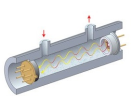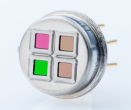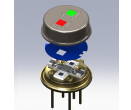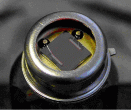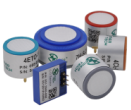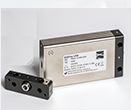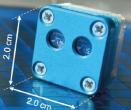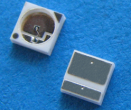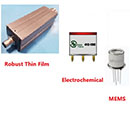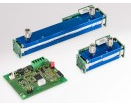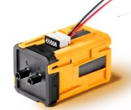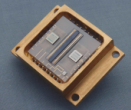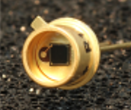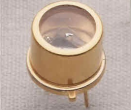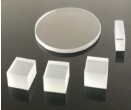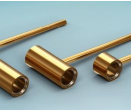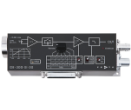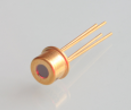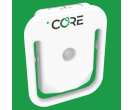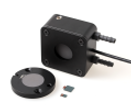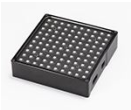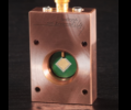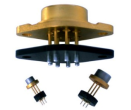If you need sensing solutions in the UV (ultraviolet), the Near IR (NIR, Near Infrared) and Mid IR (Mid Infrared) we have them with an array of different technologies that make great sensors in specific wavelength ranges.
NDIR Gas Sensors / Detectors
EOC offers several solutions for NDIR gas detection and sensing., including lasers for NDIR gas detection.
Thermopile Detectors
Thermopile detectors / sensors / arrays are easy to use
Pyroelectric Detectors
Pyroelectric detectors are reliable
Encapsulated PbS
Detectors & Arrays
Fast, sensitive and STABLE PbS
Pulsable IR Sources
Improve the response of Pyroelectric, Thermopile or PbS and PbSe infrared sensors and detectors in a nondispersive infrared gas detection system.
Electrochemical Sensors
Electrochemical sensors from SemeaTech focus on detection of a variety of hazardous gases for work safety and environmental protection. Photoionization (PID) Sensors are a simple plug and play sensor providing a dynamic and dependable response to volatile organic compounds.
High Performance Fluorescence Detection
Accurate, high sensitivity, compact and broad dynamic range fluorescence detector
World’s Smallest Oxygen Gas Sensor
This O2 (Oxygen) Sensor is compact and uses very low power, ideal for mobile applications.
Mid-IR Photodiodes and Narrowband LEDs
The “solid state” way of detecting in the Mid IR is to use Mid-IR Photodiodes and Narrowband Mid-IR LEDs that are simple to operate and have fast response.
H2 Sensors / Hydrogen Sensors
Stand alone Robust H2 Sensors, Electrochemical H2 Sensors and MEMS H2 Sensors
NDIR Gas Sensor Modules
Using NDIR Gas Sensor Modules from smartGAS, you can monitor fruit storage, SF6 gas in high voltage applications, emissions, gases in processes and refrigerant gases.
Micro Pumps for NDIR Gas Sensor Modules
High reliability Micro Pumps for NDIR Gas Sensor Modules with unique design that outperforms regular diaphragm pumps.
PbS and PbSe infrared linear arrays
PbS and PbSe IR linear arrays are used for spectroscopy applications to monitor several wavelengths in the mid IR spectrum. With densities up to 512 pixels the resolution is excellent.
UV, UV-VIS Photodiodes and
APDs – SiC, GaN & InGaN
EOC offers solutions for UV detection and monitoring using solar blind UV photodiodes / detectors made from Silicon Carbide (SiC) for high performance and Gallium Nitride (GaN) for medium performance. These detectors can be used in UV Probes and UV Sensor Boards; InGaN for UV-VIS applications; SiC APDs for flame detection. UV Monitors, Meters and Radiometers. If you want to monitor UV and Visible light, the UV-Visible Photodiodes are the solution.

High Sensitivity Flame Detectors
High Sensitivity Flame Detection using UV SiC APDs.
Hydrogen (H2) Flame Detection using a UV Probe
Flame Detection Systems
Flame detection systems using Pyroelectric and thermopile detectors / sensors are reliable and cover a broad IR band; PbS and PbSe infrared detectors are fast and very sensitive.
Scintillator Crystals and Ceramics
For Medical Imaging, High Energy Physics, Gamma Detection and more
Gas Filter Cells
Eliminate cross-sensitivity to gasses with similar IR signatures in an NDIR gas detection system
Silicon Photodiodes with Low Noise Amplifier
Photoreceivers – Si / InGaAs
FEMTO couples Silicon Photodiodes with Low Noise Amplifiers for high gain for weak signals. Photoreceivers with Si and InGaAs photodiodes are available.
Temperature Sensor Modules / Radiometers
Thermopiles are excellent Temperature Sensor Modules or Radiometers.
The CORE System is a “Disruptive Technology”
Continuous Core Body Temperature Monitoring ideal for COVID-19 related symptoms monitoring; Easy to use & Reliable

Infrared Human Body Measurement Products
A complete set of options for monitoring body temperature at work or in high traffic areas.
Heat Flux and Radiation Sensors
greenTEG offers Heat Flux and Radiation Sensors (gRAY®) as well as Thermoelectric Generators (gSKIN®). The gRAY® Radiation Sensor is especially suited for measuring laser power and solar radiation. Other applications include thermal measurements in buildings and calorimetry. gSKIN®s are used for a variety of Heat Flux measurement.
2D UV Sensor Arrays
2D UV Sensor Arrays can measure two dimensionally from a wide range of UV light sources.
Temperature, Conductivity, Flow and Humidity Sensors
Temperature sensors, flow sensors, humidity sensors, conductivity sensors and biosensors (and modules combining one or more of these)
Bio and Chemical Sensors
Diamond UV / X-Ray Detectors
Gamma(y)Ray-Radiometer
EOC offers diamond detectors for Diamond UV and X-Ray Detectors, Bio and Chemical Sensors and Gamma (y) Ray Radiometers. Diamond’s superior properties are effective for light sources as well as for detecting minimum ionizing particles in High Energy Physics applications where the detector is exposed to high doses of radiation. Diamond detectors are also used for beam alignment in high beam energy applications.
Radiation Alarm Monitors & Detectors: X, y and Gamma
Cesium Iodine Gamma Sensor Module consisting of a cesium iodide crystal, a photodiode, and a high-gain preamplifier. Gamma personal radiation alarm. Mini-Gamma sensor with a compact mechanical design allowing the sensor to be used in small digital devices
Sockets & Interconnects
Sockets and Interconnects for your radial components

